The Ultimate Keto Grocery Guide: Top 10 Essential Foods for Weight Loss & Energy – What to Buy for Success on a Ketogenic Diet
This post may contain affiliate links. If you purchase through these links, I may earn a small commission at no extra cost to you. LEARN MORE.
Starting a ketogenic diet requires a strategic approach to grocery shopping and meal planning. The right food choices can make the difference between success and frustration when transitioning to this low-carb, high-fat lifestyle.
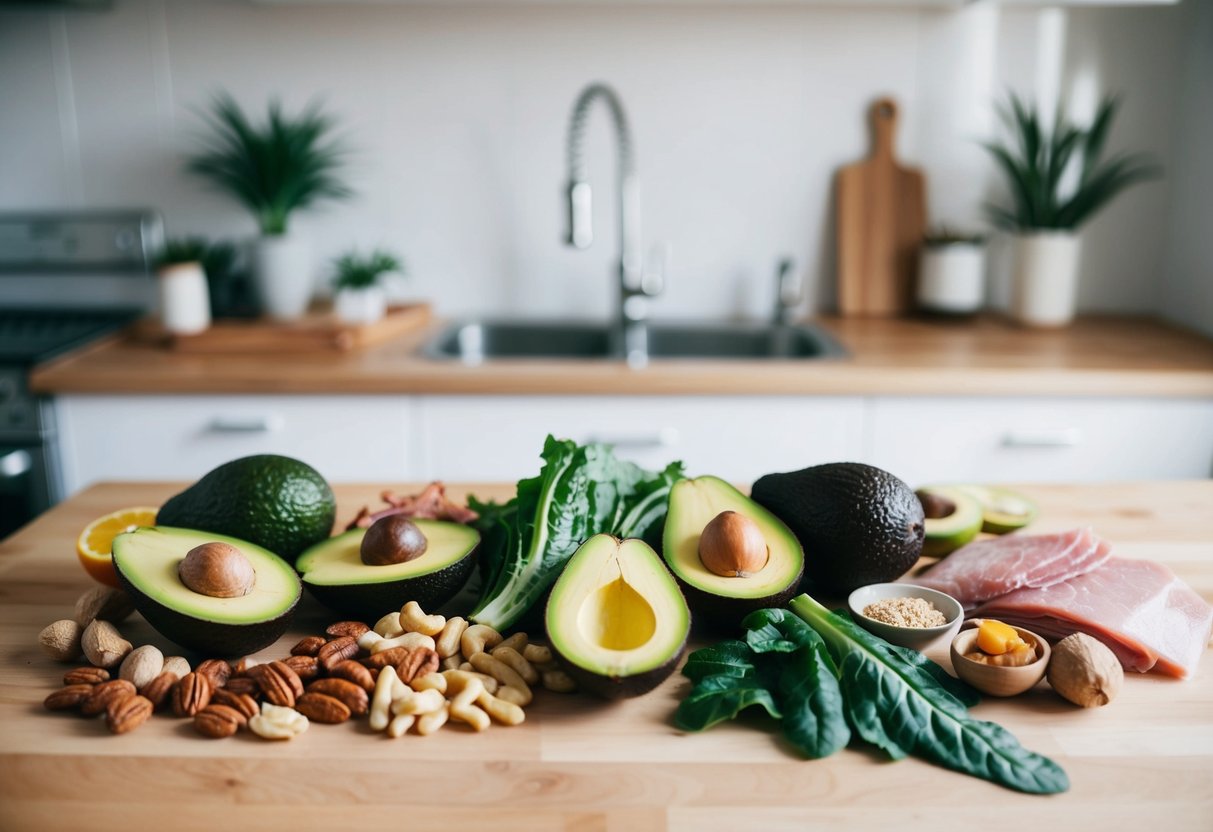
A well-planned keto grocery list focuses on healthy fats, quality proteins, and low-carb vegetables while eliminating processed foods and sugary items.
The ketogenic diet transforms your body’s primary fuel source from glucose to fat, promoting weight loss and sustained energy levels throughout the day.
By selecting wholesome ingredients like salmon, grass-fed meats, leafy greens, and healthy oils, you create a foundation for nutritious keto meals that support your health goals.
Learn more about keto fundamentals in our Keto Diet Basics guide
Key Takeaways
- A successful keto diet requires 70-80% of calories from healthy fats, including avocados, olive oil, and fatty fish
- Quality protein sources and low-carb vegetables form the backbone of effective keto meal planning
- Strategic grocery shopping with a focus on whole, unprocessed foods ensures sustainable success on the ketogenic diet
Foundations of the Keto Diet
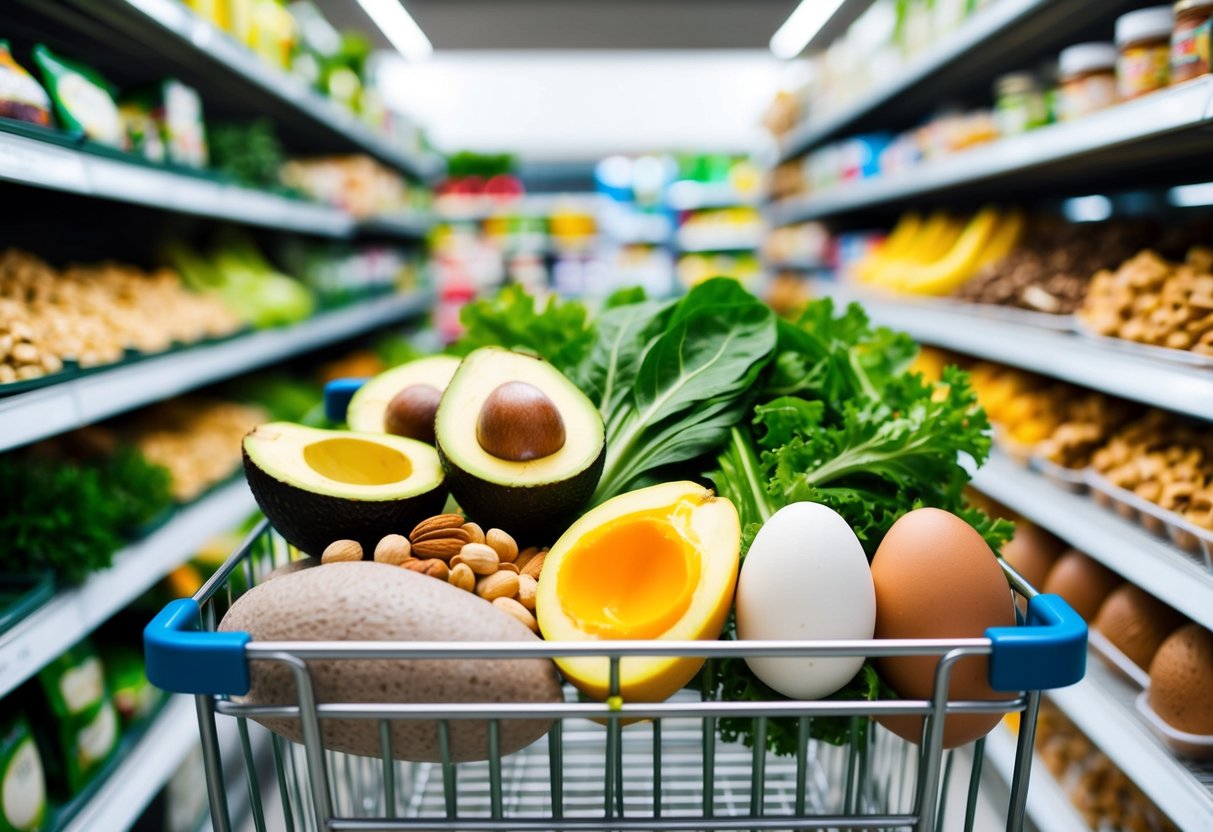
The ketogenic diet transforms the body’s metabolic state through precise macronutrient ratios and strategic food choices. This metabolic shift delivers powerful benefits for weight management and energy production.
Understanding Ketosis and Macros
Ketosis occurs when the body switches from using glucose to burning fat for fuel.
The standard ketogenic diet requires consuming 70-80% of calories from fat, 20-30% from protein, and 5% or fewer from carbohydrates.
These specific macronutrient ratios prompt the liver to produce ketones, which serve as an alternative energy source for the brain and body.
Daily carbohydrate intake typically stays below 20-25 grams to maintain ketosis. Tracking macros is essential during the initial adaptation phase.
Health Benefits of a Ketogenic Lifestyle
The ketogenic diet supports steady energy levels throughout the day by stabilizing blood sugar. Many people report improved mental clarity and focus after adapting to ketosis.
Research indicates potential benefits for:
- Weight management and fat loss
- Blood sugar regulation
- Mental performance
- Sustained energy levels
- Reduced inflammation
The body becomes more efficient at burning fat during ketosis, which can lead to improved body composition. Athletic performance often improves once the body adapts to using ketones for fuel.
Proper electrolyte balance and adequate hydration help maximize these benefits while minimizing adaptation symptoms.
Learn more about keto diet for athletes follow our guide to enhancing performance naturally
Crucial Fats and Oils for Keto
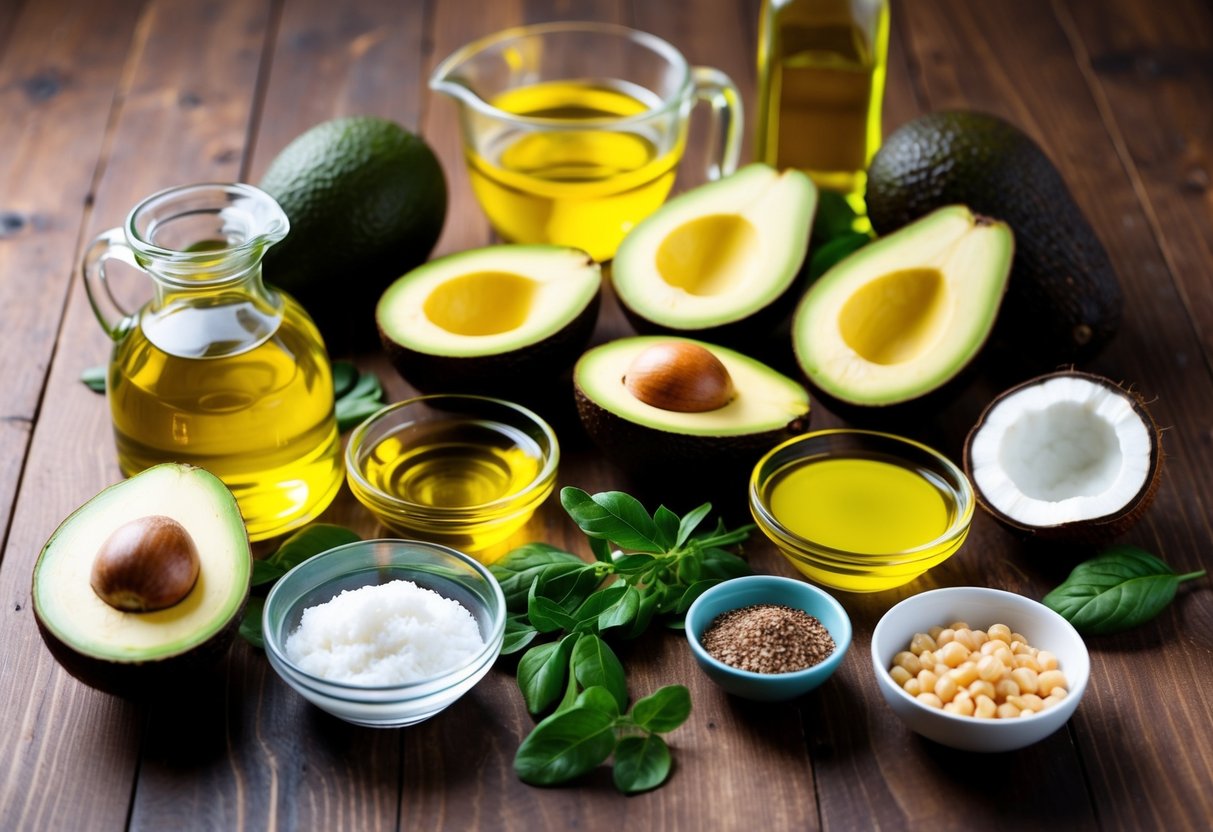
Dietary fats form the cornerstone of ketogenic nutrition, providing up to 75% of daily caloric intake. The right selection of fats and oils can optimize ketone production and enhance metabolic flexibility.
Navigating Healthy Fats and Keto
Extra virgin olive oil stands as a premium choice for keto, packed with heart-healthy monounsaturated fats and antioxidants. A daily intake of 2-3 tablespoons supports optimal fat consumption.
Grass-fed butter delivers concentrated nutrients like vitamin K2 and CLA, while providing stable cooking properties up to 350°F.
Top Cooking Fats for Keto:
- Coconut oil (smoke point: 350°F)
- Grass-fed butter (smoke point: 350°F)
- Extra virgin olive oil (smoke point: 325-375°F)
- Avocado oil (smoke point: 520°F)
The Role of MCTs in Energy and Weight Loss
Medium-chain triglycerides (MCTs) convert rapidly into ketones, providing quick energy without glucose spikes.
Coconut oil naturally contains about 60% MCTs, making it valuable for ketogenic diets.
Pure MCT oil supports faster ketone production compared to long-chain fats. Starting with 1 teaspoon daily and gradually increasing prevents digestive discomfort.
MCT supplementation can increase energy expenditure by 5% and support fat oxidation during exercise. The C8 and C10 forms prove most effective for ketone production.
A combination of MCT oil and exercise enhances weight loss results through increased metabolic rate and appetite reduction.
Check out the best selling oil from Amazon below.
Optimal Protein Choices

High-quality protein sources form the foundation of a successful ketogenic diet, providing essential amino acids while supporting weight loss and muscle maintenance.
Meat and Seafood Selection
Wild-caught fatty fish delivers omega-3 fatty acids and complete protein. Salmon, mackerel, and sardines rank among the best choices for their nutrient density and low mercury content.
Grass-fed beef contains higher levels of nutrients compared to conventional meat. Select cuts with moderate fat content like ribeye, sirloin, and chuck roast.
Free-range poultry offers lean protein options. Choose dark meat cuts from chicken and turkey for higher fat content, keeping skin on for additional nutrients.
Fresh shellfish provides zinc and selenium. Opt for oysters, mussels, and shrimp as excellent low-carb protein sources.
Eggs and Dairy Essentials
Premium Egg Sources:
- Pasture-raised eggs
- Omega-3 enriched eggs
- Farm-fresh local eggs
Full-fat dairy products complement the keto diet while providing calcium and protein. Select grass-fed butter, heavy cream, and aged cheeses like cheddar, gouda, and brie.
Greek yogurt and cottage cheese serve as versatile protein options. Choose plain, full-fat varieties without added sugars or stabilizers.
Hard cheeses contain minimal lactose and maximum protein. Parmesan, Swiss, and provolone make excellent snack choices.
Keto-Friendly Vegetables and Greens
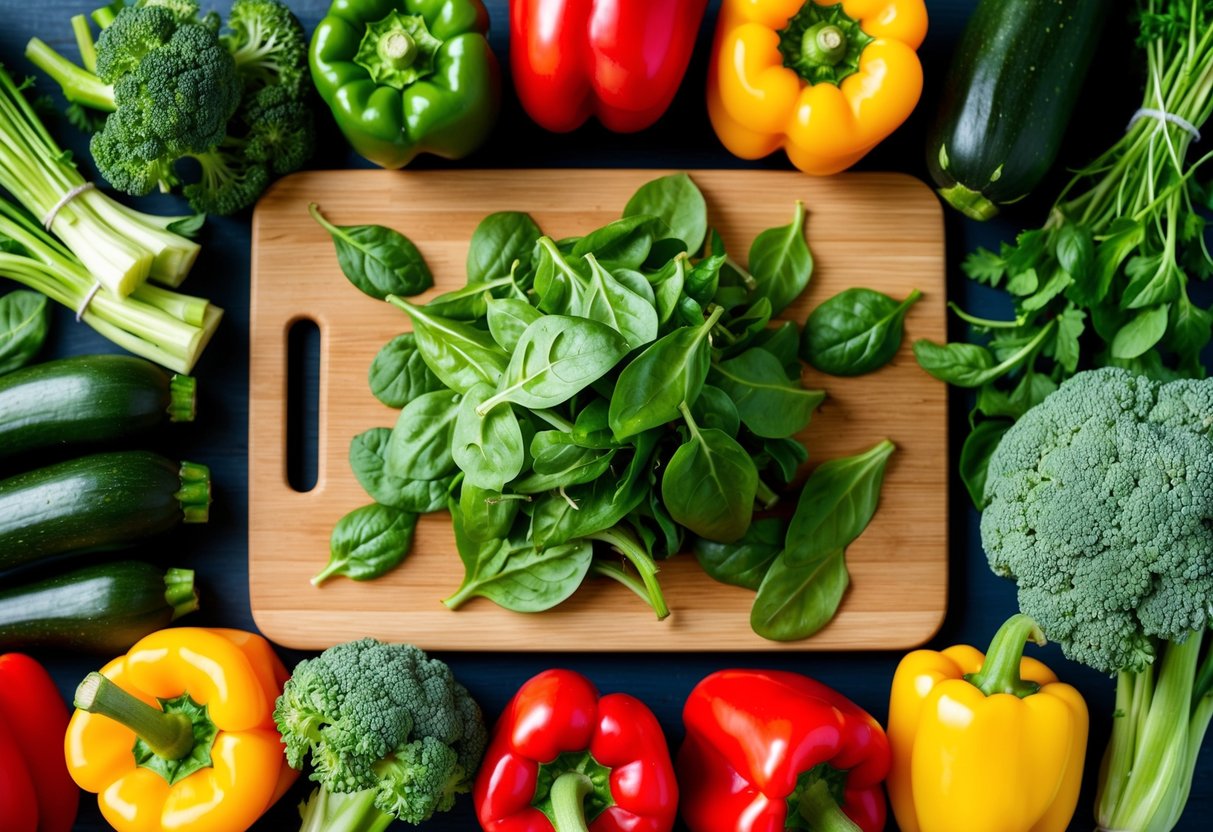
Vegetables and greens form the nutritional foundation of a ketogenic diet, providing essential vitamins and minerals while keeping carbohydrates low. The key is selecting options that deliver maximum nutrients with minimal carb impact.
Leafy Greens and Salad Options
Spinach, kale, and Swiss chard rank among the most nutrient-dense leafy greens for keto, containing less than 1g net carbs per cup. These powerhouses pack significant amounts of potassium, magnesium, and vitamin K.
Lettuce varieties like romaine, arugula, and butter lettuce make excellent salad bases with virtually zero carbs. Mix these with high-fat toppings like avocados and olive oil for satisfying keto meals.
Microgreens and sprouts offer concentrated nutrition while staying extremely low in carbohydrates. These tender greens make excellent garnishes and sandwich alternatives.
Selecting Non-Starchy Vegetables
Green bell peppers, cucumber, and celery provide refreshing crunch with minimal carbs – typically 2-3g net carbs per serving. These vegetables work well raw or cooked.
Cruciferous vegetables like broccoli, cauliflower, and cabbage contain 3-4g net carbs per cup. Their fiber content makes them filling while supporting digestive health.
Zucchini and asparagus serve as versatile low-carb options, perfect for side dishes or as pasta alternatives. Both contain approximately 2g net carbs per serving.
Note: Track portion sizes of even keto-friendly vegetables, as carbs can add up throughout the day. For detail of keto vegetable, please follow our guide.
Strategic Carb Choices and Alternatives
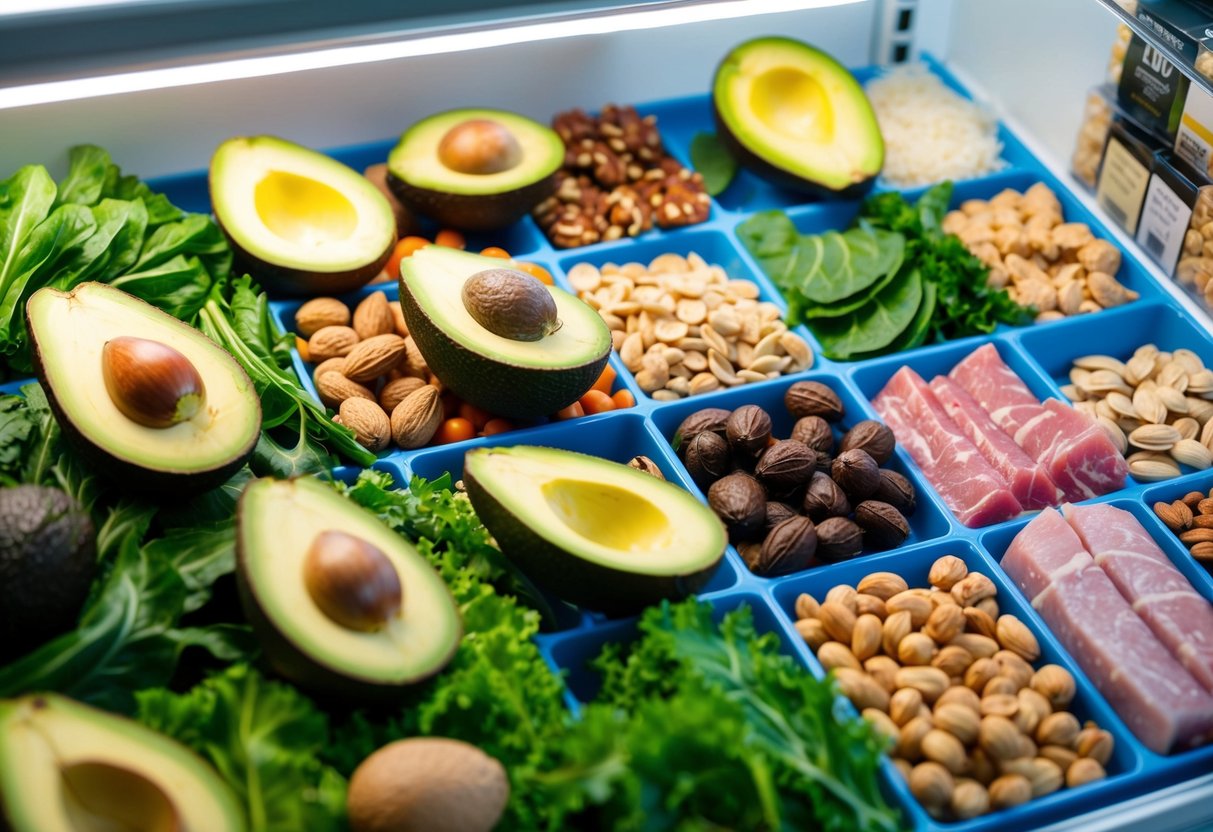
Smart substitutions for traditional high-carb ingredients enable keto dieters to enjoy familiar foods while maintaining ketosis. The right sweeteners and baking supplies make the difference between success and failure on a ketogenic diet.
Understanding Low-Carb Sweeteners
Natural sugar alternatives like erythritol and monk fruit provide sweetness without impacting blood sugar levels. These options contain zero net carbs and work well in both hot and cold applications.
Stevia stands out as a plant-based sweetener with no calories and no effect on glucose levels. Many find it works best when combined with erythritol to minimize any aftertaste.
Sugar alcohols like xylitol offer another viable option, though some people may experience digestive sensitivity. It’s crucial to check labels for hidden carbs in blended sweetener products.
Choosing Keto-Appropriate Baking Supplies
Almond flour and coconut flour serve as the foundation for keto baking. These alternatives contain significantly fewer carbs than wheat flour while providing beneficial fiber and nutrients.
Psyllium husk powder and xanthan gum act as essential binding agents in low-carb baking. These ingredients help achieve the proper texture in breads and pastries.
Key Keto Baking Staples:
- Almond flour
- Coconut flour
- Psyllium husk powder
- Xanthan gum
- Ground flaxseed
Coconut flour absorbs more liquid than traditional flour, requiring recipe adjustments. Using 1/4 cup coconut flour typically replaces 1 cup of wheat flour.
Snacks and Convenience Foods
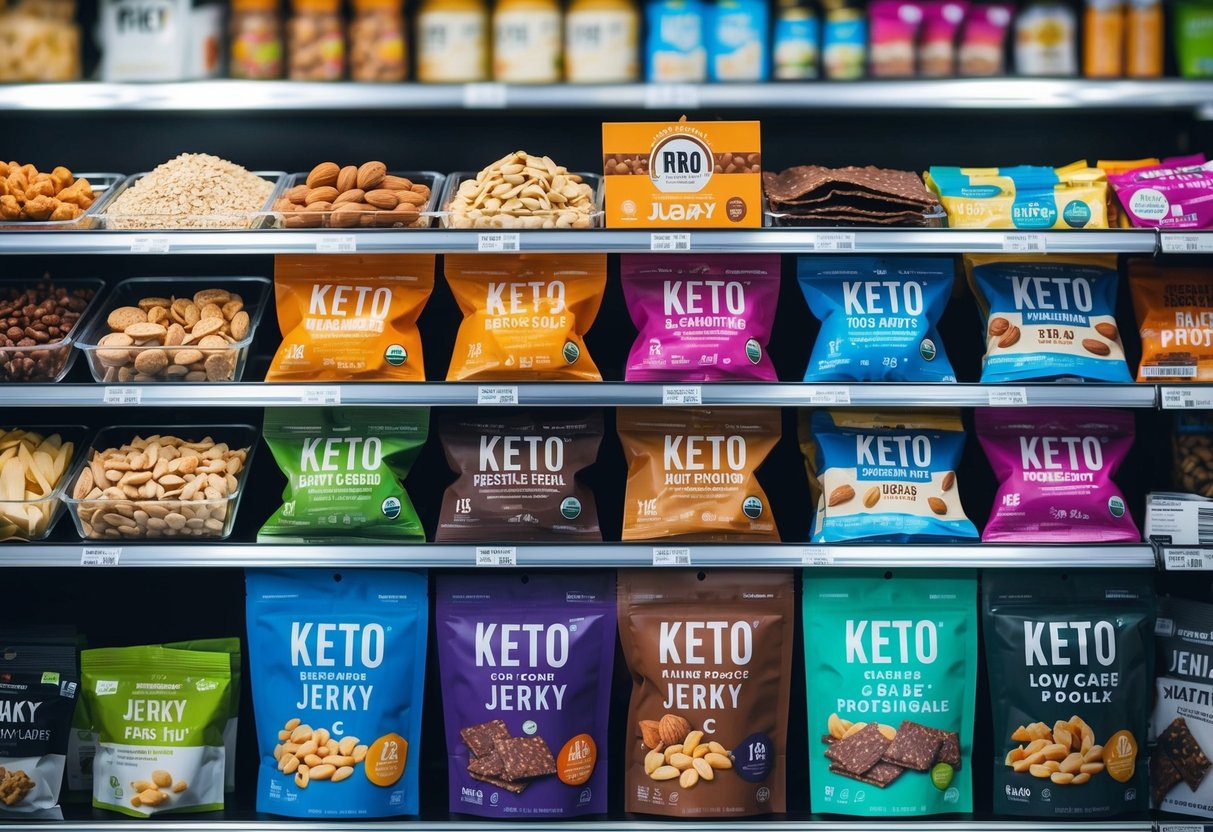
Quick and portable keto-friendly snacks help maintain energy levels while staying in ketosis. Smart snack choices prevent hunger between meals and support weight loss goals.
Healthy Keto-Friendly Snacking Ideas
Nuts serve as excellent grab-and-go snacks, with macadamia nuts and almonds offering ideal fat-to-protein ratios. Keep portions to 1-2 ounces to manage calories.
Olives pack healthy fats and electrolytes into a convenient package. A serving of 5-7 olives provides satisfying fats without excess carbs.
Protein-Rich Options:
- Sardines (0g carbs, 23g protein per can)
- Hard-boiled eggs
- String cheese
- Pre-cooked bacon
Seed-Based Snacks:
- Chia seeds mixed with unsweetened coconut milk
- Pumpkin seeds
- Sunflower seeds
Navigating Processed Foods and Keto Snacks
Pre-packaged keto snacks can support a low-carb lifestyle when whole foods aren’t available.
Check labels for hidden sugars and starches.
Watch Out For:
- Sugar alcohols
- Modified starches
- Maltodextrin
- High-fructose corn syrup
Store-bought options like pork rinds, beef jerky, and sugar-free protein bars work in moderation.
Focus on products with five ingredients or fewer.
Diet sodas and sugar-free beverages fit into keto macros but should be limited to 1-2 servings daily to minimize artificial sweeteners.
Find out 10 quick keto snack here to keep you energized all day.
Building Your Keto Grocery List
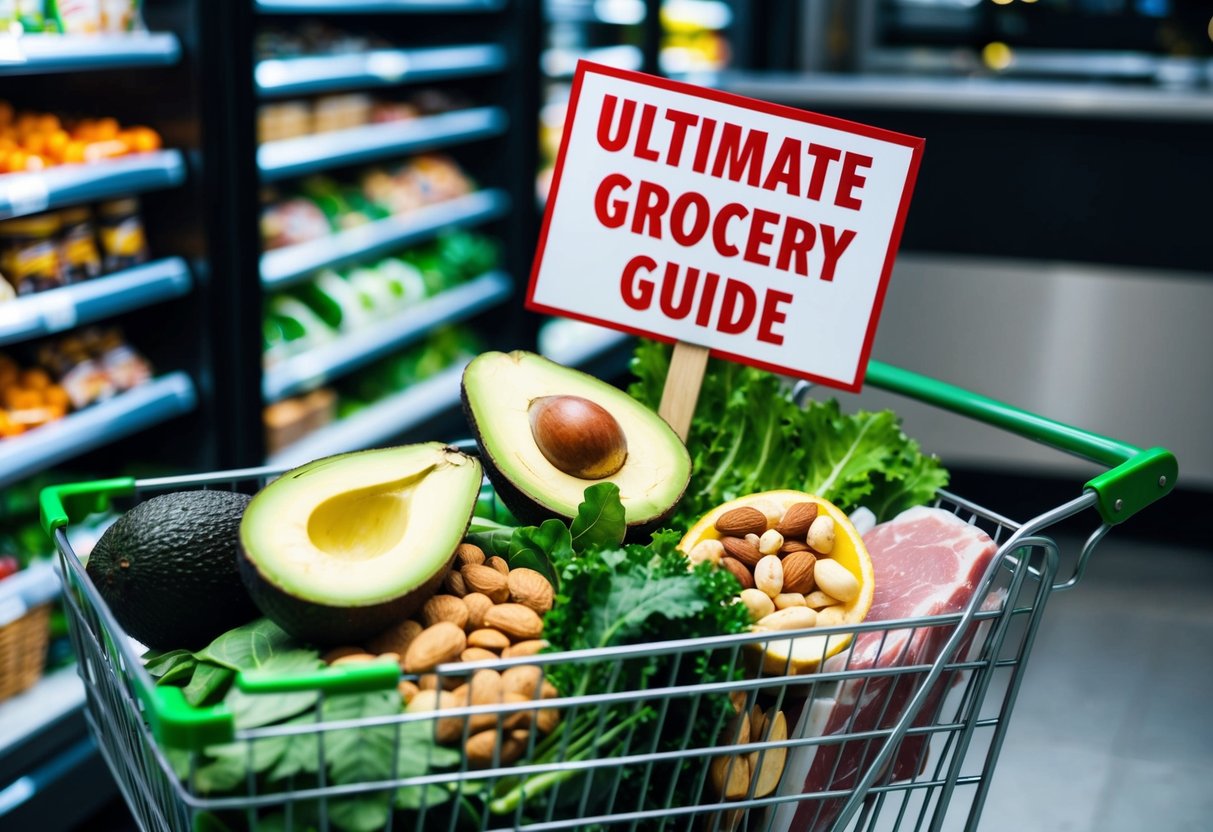
A well-organized keto shopping list focuses on high-fat, moderate-protein foods while eliminating most carbohydrates.
Success on the ketogenic diet starts with proper planning and selecting the right ingredients.
Essentials for Your Keto Pantry
Stock these staple items to maintain a functional keto kitchen:
Healthy Fats
- Olive oil, coconut oil, avocado oil
- Grass-fed butter, ghee
- Nuts and seeds (almonds, macadamia, chia)
Proteins
- Eggs
- Fatty fish (salmon, mackerel, sardines)
- Red meat, poultry, pork
Low-Carb Vegetables
- Leafy greens (spinach, kale)
- Cruciferous vegetables (broccoli, cauliflower)
- Zucchini, asparagus, bell peppers
Meal Prep and Planning Tips
Create a weekly meal schedule before shopping.
This reduces waste and improves adherence to the diet.
Store prepped vegetables in clear containers at eye level in the refrigerator for easy access.
Batch cook proteins and divide into portion-sized containers.
Freeze extra portions for busy days.
Keep hard-boiled eggs ready for quick snacks or protein additions to meals.
Budget and Seasonal Tips
Shop for seasonal vegetables to reduce costs and maximize nutrient content.
Buy meat in bulk when on sale and freeze in portions.
Check local farmers’ markets for fresh, affordable produce and eggs.
Consider frozen vegetables as a cost-effective alternative to fresh produce.
Join wholesale clubs for savings on keto staples like nuts, oils, and meat.
Need help organizing your meals? Explore our Custom Keto Diet Plan for tailored meal strategies!
Supplements and Extras
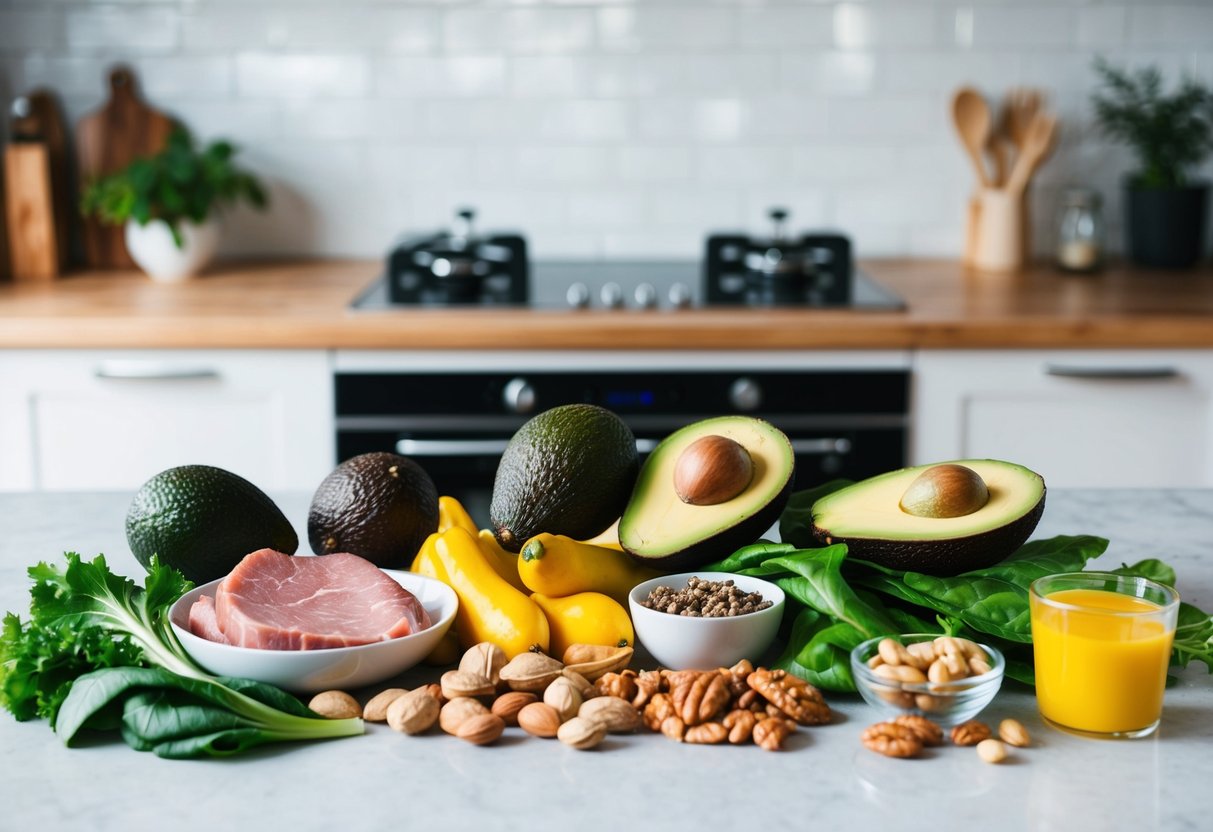
While a well-planned keto diet provides most essential nutrients, strategic supplementation can enhance results and support metabolic adaptation.
Targeted supplements help maintain energy levels, electrolyte balance, and optimal nutrition.
Key Keto Supplements
MCT oil supports ketone production and provides quick energy for body and brain.
Start with 1 teaspoon daily and gradually increase to avoid digestive issues.
Omega-3 fatty acids from fish oil reduce inflammation and support brain health.
A daily dose of 2-3 grams helps balance omega-3 to omega-6 ratios.
Bone broth supplies minerals, collagen, and amino acids.
Choose quality brands or make it at home using grass-fed bones.
Electrolytes and Hydration
Pink Himalayan salt contains trace minerals and helps maintain sodium levels.
Add 1/4 teaspoon to water throughout the day.
Magnesium supplements (200-400mg daily) prevent muscle cramps and support sleep quality.
Potassium from food sources or supplements prevents fatigue and maintains heart health.
Target 3,000-4,000mg daily from all sources.
Protein Powders and Nutritional Boosters
Clean, low-carb protein powders support muscle maintenance and recovery.
Select options with less than 2g carbs per serving.
Collagen protein specifically targets skin, joint, and gut health.
Mix 10-20g into morning coffee or smoothies.
Antioxidant supplements like CoQ10 and alpha-lipoic acid support metabolic health and energy production.
Consider adding these based on individual needs and consultation with healthcare providers.
Check out top selling keto grocery lists from Amazon below.
Frequently Asked Questions
The ketogenic diet requires specific food choices and shopping strategies to maintain optimal ketosis levels for effective weight loss and sustained energy throughout the day.
What foods should be included when starting a ketogenic diet?
Start with high-quality fats like avocados, olive oil, and coconut oil. These form the foundation of ketogenic nutrition.
Include protein sources such as eggs, chicken, beef, and fatty fish. These provide essential amino acids while maintaining appropriate macronutrient ratios.
Fresh, low-carb vegetables like spinach, kale, and cauliflower supply necessary nutrients without excess carbohydrates.
How can I identify keto-friendly foods while shopping at the grocery store?
Check nutrition labels for total carbohydrates and fiber content. Net carbs should be under 5 grams per serving.
Focus on whole, unprocessed foods located along the store’s perimeter. These areas typically contain meat, produce, and dairy sections.
Which foods are absolutely essential to maintaining a successful keto diet?
Eggs serve as a versatile protein and fat source that can be prepared in multiple ways.
Fatty meats and fish provide essential proteins and healthy fats that help maintain ketosis.
Low-carb vegetables and high-fat dairy products round out the essential keto food groups.
What types of food should I avoid to stay in ketosis?
Grains, including bread, pasta, and rice, must be eliminated from the diet.
Sugar-containing foods and beverages will disrupt ketosis and should be avoided completely.
Most fruits contain too many carbohydrates and should be limited or eliminated, except for small portions of berries.
Is there a variety of foods that can be eaten in unlimited quantities on a keto diet?
Leafy greens like spinach, kale, and lettuce can be eaten in large quantities.
Most above-ground vegetables can be consumed generously while staying within daily carb limits.
How quickly can significant weight loss be expected when following a keto diet?
Initial weight loss of 2-10 pounds may occur in the first week, primarily from water weight.
Sustainable fat loss typically ranges from 1-2 pounds per week when following a well-formulated ketogenic diet.
Conclusion
Starting a ketogenic diet becomes straightforward with the right grocery list.
A well-stocked kitchen featuring healthy fats, quality proteins, and low-carb vegetables sets the foundation for success.
Focusing on whole, nutrient-dense foods supports sustainable weight loss and steady energy levels.
The combination of fatty fish, grass-fed meats, non-starchy vegetables, and natural fats provides essential nutrients while maintaining ketosis.
Regular shopping for keto-friendly items helps maintain dietary compliance.
Having key ingredients like spices, oils, and versatile proteins ready makes meal preparation efficient and enjoyable.
Success on the ketogenic diet comes from making informed food choices.
A properly planned grocery list transforms the shopping experience from overwhelming to empowering.
The right food selections support both short-term goals and long-term health benefits.
By sticking to this essential food guide, following a ketogenic lifestyle becomes a natural part of daily routines.
Ready to transform your body? Click the button below to try our 8 weeks Keto personalized meal plan and start your journey today!









